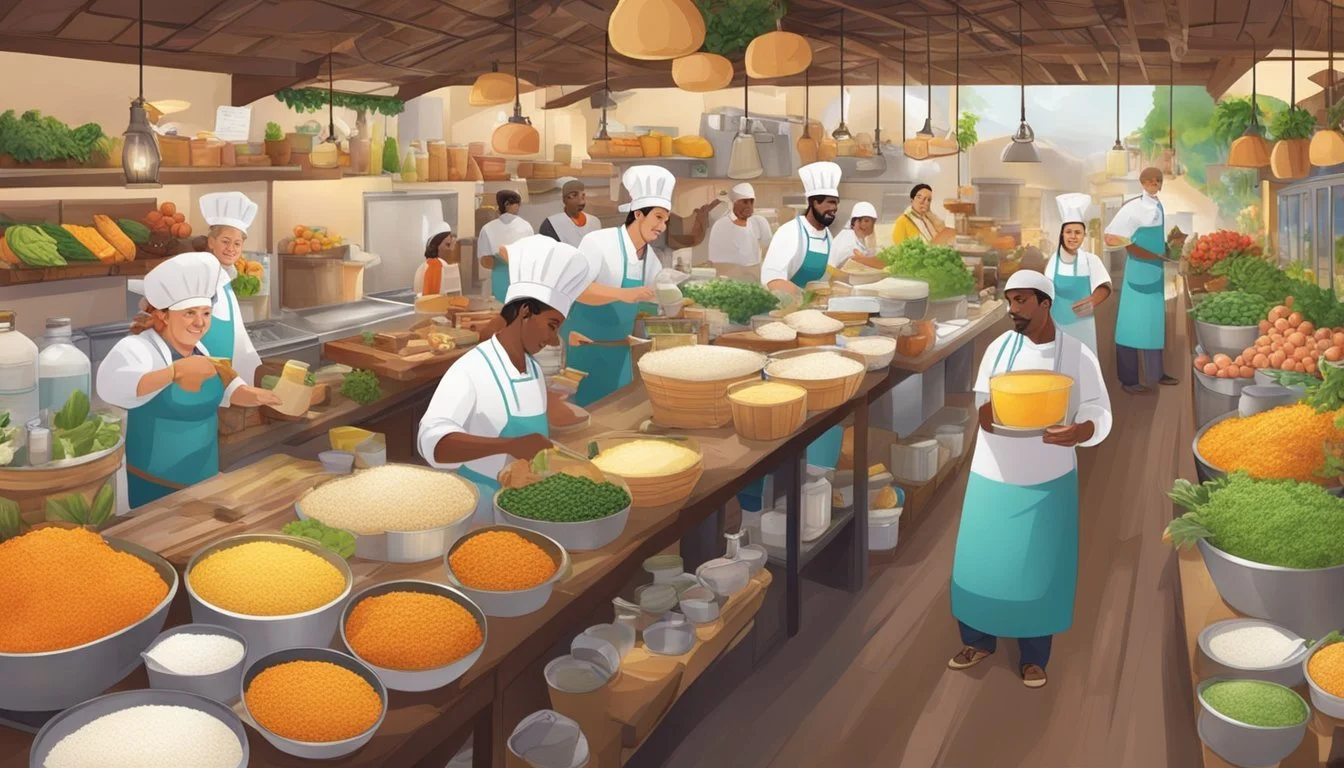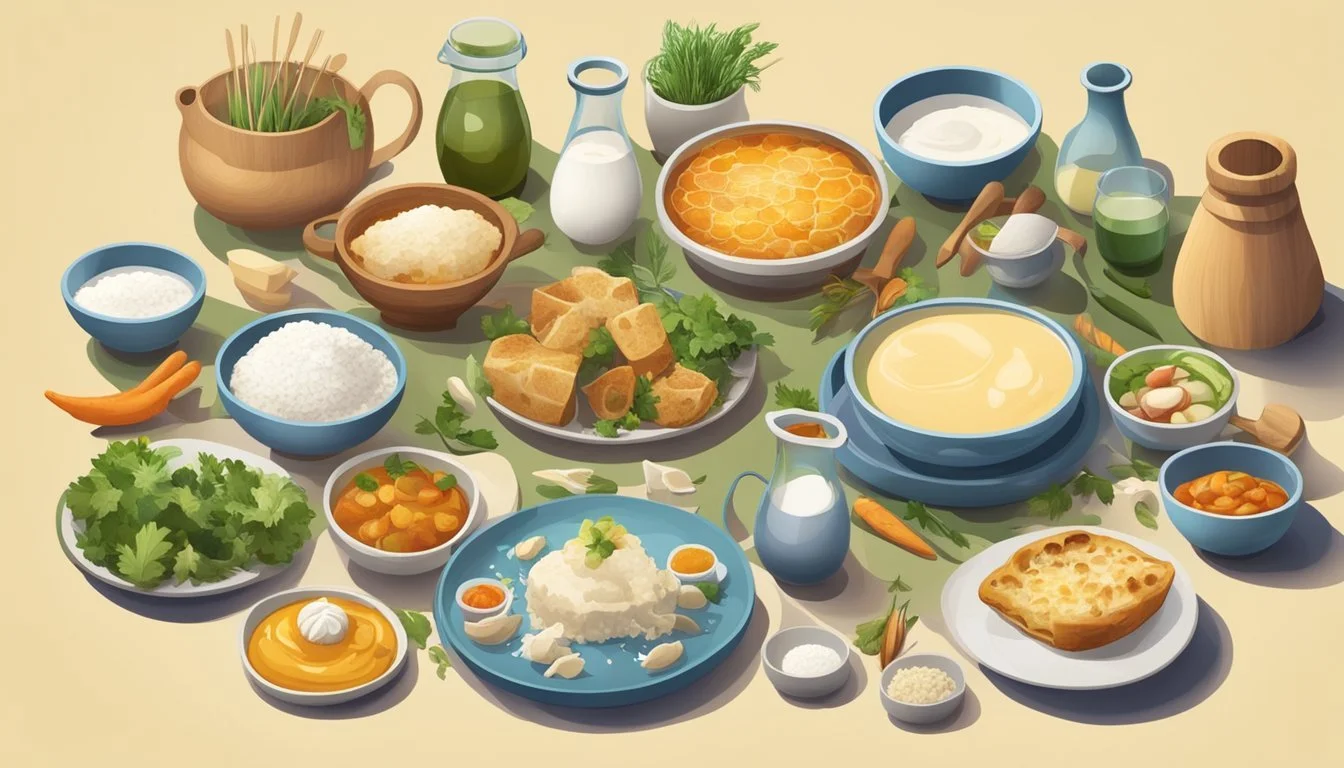Goat Milk in World Cuisine
A Guide to Global Culinary Creations
Goat milk boasts a rich history in culinary traditions around the world, renowned not only for its distinct taste but also for its versatility in a myriad of recipes. In every corner of the globe, from Mediterranean shores to African villages, goat milk is a staple ingredient, offering a creamy texture and a nutrient-rich profile that enhances the flavor of various dishes. Often touted for its easier digestibility and higher content of essential fatty acids compared to cow's milk, goat milk is a choice ingredient for both classic and innovative cuisine.
Incorporated into dishes ranging from tangy cheeses to sumptuous desserts, goat milk imparts a unique twist to conventional recipes and invites a fusion of global culinary delights. Chefs and home cooks alike take advantage of its smooth consistency, using it to create both sweet and savory creations, such as indulgent goat milk fudge or a hearty quinoa dish with roasted cauliflower. The milk's natural properties also make it a choice ingredient for producing other artisanal products, including lotions, soaps, and skincare essentials that capitalize on its moisturizing benefits.
The exploration of goat milk recipes illuminates the adaptable nature of this ingredient in the realm of gastronomy. As lifestyles lean towards sustainability and health-conscious choices, goat milk is gaining popularity, not just on farmstead tables but in urban kitchens and restaurant menus worldwide. It affirms its place as a cultural cornerstone that transcends regional tastes, showcasing the endless possibilities when traditional meets contemporary in the kitchen.
Historical Significance of Goat Milk
Goat milk has been a fundamental part of human diets and cultures for millennia, with ancient civilizations recognizing both its nutritional value and culinary versatility.
Origin of Goat Dairy Products
The practice of milking goats for human consumption dates back thousands of years. It is said that these dairy products have their roots in the regions that today encompass Iran and Afghanistan. Archaeological findings suggest that goats were one of the first animals to be domesticated for agricultural purposes, including the production of goat cheese. The pastoral communities relied heavily on goats for their milk, which was easier to digest and more suitable for the nomadic lifestyle than cow's milk.
Role of Goat Milk in Ancient Cuisines
Historically, goat milk has played a crucial role in the cuisine and cultures of many civilizations. In Greece, goat milk and its by-products have been staples since the times of Homer. Cheese made from goat milk, known as feta, has been an integral component of Greek diets since antiquity. Similarly, in France, goat cheeses (What wine goes well with goat cheeses?) like Crottin de Chavignol date back to the 16th century and are still celebrated for their distinctive flavors and textures. Goats' adaptability to diverse terrains and climates made them invaluable to many societies, particularly in harsh environments where cows could not thrive.
Throughout history, goat milk has not just been a source of sustenance but also a means of fostering sustainability. Its production requires less land and emits fewer greenhouse gases compared to cow's milk, making goats a more sustainable choice in many parts of the world.
Nutritional Profile of Goat Milk
Goat milk is renowned for its unique nutritional composition, which offers various benefits and is an essential part of many diets around the world. It serves as an excellent source of vital nutrients and is especially interesting when compared to cow milk.
Comparative Analysis: Goat Milk vs. Cow Milk
Goat milk stands out with a slightly different nutritional profile than cow milk. It generally contains:
More fat, protein, and minerals
Less lactose
These differences can affect the digestibility of goat milk, with some individuals finding it easier to digest than cow milk.
Fat: Goat Milk - 4.5%, Cow Milk - 3.25%*
Protein: Goat Milk - 3.6%, Cow Milk - 3.15%*
Lactose: Goat Milk - 4.3%, Cow Milk - 4.7%*
Minerals: Goat Milk - 0.8%, Cow Milk - 0.7%*
*Average values for whole cow milk
Essential Nutrients in Goat Milk
Goat milk is also a good source of many essential nutrients that benefit health, such as:
Calcium: Important for bone health.
Phosphorus: Assists in energy production and bone mineralization.
The protein in goat milk is high quality and includes all essential amino acids necessary for human health. Additionally, the fat content in goat milk is enriched with medium-chain fatty acids, which are believed to be metabolized more readily by the human body. The minerals found in goat milk, such as calcium and phosphorus, are crucial for maintaining strong bones and teeth, as well as supporting broader metabolic functions. Despite its nutritional benefits, goat milk should be consumed in moderation as part of a balanced diet.
Culinary Uses of Goat Milk
Goat milk, with its rich and tangy flavor profile, is a versatile ingredient that enhances a wide array of recipes in various culinary traditions. It is esteemed for its digestibility and nutrient-rich composition, making it a beneficial choice for both traditional and contemporary dishes.
Traditional Goat Milk Recipes
In traditional cuisines, goat milk is primarily celebrated for its role in the production of cheeses such as feta and ricotta. These cheeses are staples in regional cooking, appearing in classic dishes such as the Greek salad, where feta provides a salty bite, and in Italian pastas and desserts, where ricotta adds creaminess and light texture.
Feta: Salty, crumbly cheese used in Greek salads and pastries.
Ricotta: Soft cheese used for filling pasta and in cheesecakes.
Beyond cheese, traditional recipes also employ goat milk in its unaltered form. For example, goat milk is often used to create rich, creamy yogurt that can be found in various Middle Eastern and South Asian dishes. Goat milk butter is another derivative, though less common, it imparts a distinct flavor in baked goods and sautés.
Goat Milk in Modern Cooking
Modern culinary practices have expanded the horizons of goat milk usage. Chefs and home cooks alike now integrate goat milk into innovative dishes, showcasing its adaptability.
Goat Milk Butter: A rare find with a unique taste for sautéing and baking.
Goat Milk Ice Cream: A novel dessert with a refined, tangy twist on traditional ice cream.
Goat Milk in Beverages: Lattes and smoothies enriched with a creamy consistency.
Furthermore, as the interest in artisanal and homemade foods grows, many individuals are venturing into making their own goat milk products at home. This includes crafting homemade yogurts, ice creams, and experimenting with curing their own cheeses, where goat milk provides a distinctive flavor profile that sets their creation apart.
Goat Milk in World Cheese Production
Goat milk is a key ingredient in an array of regional cheeses around the globe. These cheeses are highly valued for their unique flavors and textures, which are imparted by the varied processing methods and the local terroirs.
Prominent Goat Cheeses by Region
Europe: Europe boasts a rich tradition of goat cheese production, many of which hold protected designation of origin (PDO) status. France, for instance, is renowned for its chèvre, a term that encompasses various goat cheeses. The Loire Valley alone offers famous varieties such as Valençay and Crottin de Chavignol.
Spain: Another prominent country, Spain, contributes with its own PDO cheese, like the creamy Murciana.
Netherlands: Dutch Goat Gouda is noted for its sweet, nutty flavor profile, often compared to caramel.
Asia:
India: India leads in goat milk production, with cheeses that are often fresh, spreadable varieties integral to local cuisines.
Artisanal Goat Cheese Making
Artisanal cheese producers often embrace traditional methods handed down through generations. The process involves careful attention to detail, ranging from the quality of the milk to the specific strains of bacteria used during fermentation.
Fermentation: The natural acidity and unique enzymes present in goat milk require adapted fermentation techniques.
Aging: Artisanal cheeses may be aged in various environments to develop their character, some creating bold and earthy notes, others a delicate and creamy texture.
Small-scale producers are instrumental in maintaining the diversity of goat cheeses available worldwide. The craft relies on the skillful balancing of science and tradition, ensuring that each cheese reflects the distinct flavor profile associated with its region and heritage.
Goat Milk Based Products and Alternatives
Goat milk boasts a variety of applications beyond mere consumption, featuring prominently in health and beauty products and serving as a versatile dairy substitute.
Health and Beauty Uses
Products derived from goat milk, such as goat milk soap and goat milk lotion, are revered for their hydrating properties. They are often utilized for their potential to soothe sensitive skin and to offer a natural alternative for hydration and nourishment in skin care routines.
Goat Milk as a Dairy Substitute
When it comes to dairy substitutions, goat milk stands as a close counterpart to cow milk due to its similar taste and nutritional profile. It is used in various recipes where cow milk is typically an ingredient. However, for those with lactose sensitivities or dietary preferences that exclude animal products, oat milk serves as a plant-based substitute possessing a creamy consistency suitable for both drinking and cooking.
Global Goat Milk Industry
The global goat milk industry has seen a steady rise in production and consumption due to its nutritional benefits and adaptability to diverse environmental conditions.
Production Systems and Goat Populations
Goat milk production is primarily driven by Asia, Africa, and America with significant contributions from local breeds, such as the Saanen and Nigerian Dwarf goats. In Asia, rapid growth in goat milk production reflects the region's large goat populations, with India being the top producer. Africa's production, while substantial, often relies on less intensive systems that utilize local goat varieties well-suited to the environment. The Saanen breed, known for high milk yield, is prevalent in many production systems globally, whereas the Nigerian Dwarf goat, prized for its butterfat content, contributes to niche market demands.
Trade and Consumption Patterns
Consumption of goat milk is on the rise, driven by its reputed health benefits and growing demand among lactose intolerant populations. The industry is responding with an increased focus on the distribution and transport of goat milk and its derivatives. Goat milk products have been gaining attention in world cuisine, with a particular increase in utilization among health-conscious consumers. This has stimulated trade, especially in regions where goat milk production exceeds local consumption. As production systems evolve to meet demand, the goat milk industry continues to adapt, underscoring the importance of sustainable practices to balance industry growth with environmental stewardship.
Challenges and Opportunities in Goat Dairy Sector
The goat dairy sector faces both environmental and ethical challenges, but also opportunities in sustainability and innovation. Understanding these can guide better practices and research, bolstering the sector's growth.
Environmental Impact and Animal Welfare
The dairy goat sector grapples with environmental concerns similar to those of other livestock industries. Sustainability efforts focus on reducing the sector's carbon footprint, optimizing water usage, and promoting ethical land management. On the welfare side, producers are urged by organizations such as the American Institute for Goat Research to uphold high standards of animal care. Implementing humane practices not only aligns with ethical duties but also influences the quality of dairy products. The challenges here are manifold, ranging from the provision of adequate shelter and nutrition to addressing the ecological consequences of waste management.
Advancements and Research in Goat Dairy
Innovation and research are essential to overcoming obstacles in dairy goat production. Leading the way is the American Institute for Goat Research, which promotes cutting-edge studies to improve herd health, enhance milk yield, and develop novel dairy products. Research in this area not only explores new feeding strategies and breeding programs to maximize efficiency and yield but also delves into the genetic markers that might lead to a higher quality and more sustainable milk production. Understanding the specific needs of dairy goats can lead to innovations that are both beneficial for the animals and the environment.
Cultural and Regional Variations
In examining the cultural and regional variations of goat milk, one notices its vital role in numerous traditional diets across the globe. Its versatility is celebrated in the Mediterranean, embraced in various non-Western cultures, and deeply ingrained in the culinary heritage of many developing countries.
Goat Milk in Mediterranean Diets
In the Mediterranean, goat milk is lauded for both its dietary and gastronomic value. It is a primary source of nutrition and is used extensively in the production of cheeses like the Greek feta and the French chèvre. These cheeses are not only staples in local diets but have also gained international acclaim for their distinctive flavors and textures.
Greece: Traditional dishes featuring feta cheese.
France: Artisanal chèvre production techniques.
Goat Milk Uses in Non-Western Cultures
Throughout non-Western cultures, goat milk finds its place in a variety of forms from fresh consumption to being a base for unique recipes. For instance, in India, goat milk is often used in the preparation of sweets and as a digestive aid, while regions like Mexico use it to create cajeta, a sweet caramel spread.
India: Goat milk in desserts and as a health tonic.
Mexico: Cajeta and other goat milk-based confections.
In the Middle East, Bangladesh, and Sudan, goat milk is integral to both daily sustenance and festive occasions. It is transformed into yogurt, used in hot beverages during winter months, and incorporated into savory dishes. Additionally, for many developing countries, goat milk is not only a dietary mainstay but also a means of economic sustenance, with small-scale farming playing a crucial role in local communities.
Middle East: Goat milk yogurts and warm drinks.
Sudan & Bangladesh: Crucial for nutrition and livelihoods.
Innovations and Future Directions
The landscape of goat milk products is rapidly evolving, driven by innovation and market trends that point toward a diverse and exciting future.
Emergence of New Goat Milk Products
In the realm of goat milk applications, culinary creativity is on full display. Products such as goat milk candles have surfaced, merging the concept of farm-to-table with home essentials. These candles are not just novel items but also speak to the versatility of goat milk and its by-products. On the food front, chefs are infusing unique flavors into traditional goat milk offerings like cheese and yogurt, making them stand out in the competitive dairy market.
The popularity of goat milk is also climbing thanks to its potential health benefits, especially its easier digestibility for some consumers when compared to cow milk. Companies are crafting new beverages, desserts, and even beauty products that promise the benefits of capra hircus, the scientific term for domestic goats, in fresh and appealing ways.
Scientific Developments and Market Trends
Scientific research has shed light on goat milk's fiber content and distinctive nutritional profile, which may aid in prevention of chronic diseases. Studies have found that goat milk can contribute to gut health and the immune system, appealing to health-conscious consumers. The market has responded: there is a noticeable growth in demand for goat milk products in industries that promote wellness and natural living.
As goat dairy brands focus on innovation, they are leaning into the environment and animal welfare, areas of consumer interest that have historically driven the rise of plant-based alternatives. This has led to investments in sustainable farming practices and transparent marketing to highlight the ethical sourcing and production of goat milk products. The future of goat milk in world cuisine looks promising as producers and consumers alike explore its full potential.








